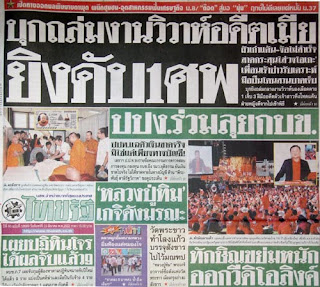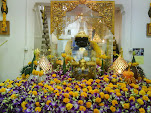Monday, 30 March 2009
Amma's Darshan
My friend who went with me was speechless... He just couldn't speak! When we ask him how does he feel? He just keep smiling and lost of word. Amma whispered something in our ear, but i really can't figure out. I believe it must be some kinds of prayers and i'm happy because my friend from india wrote down my request in Amma's language and i got the chance to pass to her and i guess the word she whisper in our ears was blessing from her.
I spoke to some followers of Amma and all of them told me Amma's darshan is powerful and has the ability to heal and change people. With a hug, she has been known to take on people's karma and physical diseases, and in so doing, clear them of their pain and illness by clearing it through her own body.
I've experienced the hug and I know i'll be there again, regardless how long the queue will be!
Friday, 27 March 2009
Boundless Compassion~Amma ( 28-30 March)
This morning, I was at the airport receiving Amma who will be here for a 3 days at Suntec City Hall 6 from 28th-30th March.
Who is Amma?
Around the world Mata Amritananadamayi Devi (AMMA) is identified as the Mother of Compassion. The press has also nicknamed her the Hugging Saint, because of her famous hug-blessings (darshans), which she has given tirelessly since she was a teenager. It is estimated that Amma has already hugged over twenty five million times.
Amma makes herself available to anyone wishing to receive her darshan. There is never a charge at public programs, and no one is excluded. Hour after hour, day after day, year after year, she receives everyone in the same loving way, irrespective of religious faith or non-belief.
On a typical tour stop, Amma will lead a brief morning meditation followed by darshan late into the afternoon. In the evening she returns to give satsang (an inspired talk), followed by an approximate 90-minute session of bhajans (devotional songs) where she leads an unusually talented troupe of swamis (monks). At the conclusion of the music she will sit, hour after hour, well into the morning hours, giving darshan.
The second way Amma reaches out is via charitable institutions, administered under the aegis of the Mata Amritanandamayi Mission. Teaching by the example of her own life, Amma blends spiritual awareness with practical social service. "Compassion to the poor is our duty to God," she instructs. "If you do spiritual practice without performing selfless actions, it will be like building a house without any doors."
At a young age, Amma concluded that human suffering stemmed almost fully from a lack of love. Thereafter she resolved to be part of the solution, thus offering her entire life as an expression of divine love.
Amma's Desire ~
"Everyone in the world should be able to sleep without fear, at least for one night. Everyone should be able to eat his fill, at least for one day. There should be at least one day when hospitals see no one admitted due to violence. By doing selfless service for at least one day, everyone should help the poor and needy. It is Amma's prayer that at least this small dream be realised."
I'll be attending the Meditation and Darshan on Sunday and i'm really looking forward to EXPERIENCE her hug!
http://www.amma.org.sg/doc/ammainnews2008.pdf
www.amma.org.sg
Note: The pic show the flower i managed to get from the garland she wore!
Wednesday, 4 March 2009
Worshipping Six Gods in Ratchaprasong area -pt 3
Trimurti
Tuesday, 3 March 2009
Worshipping Six Gods in Ratchaprasong area-pt 2
Narayana on Garuda
Narayana or Vishnu is one of the 3 great gods of Hinduism.
He was originated from Shiva's rubbing his left hand with right hand. Shiva taught all kinds of arts to Narayana and let Narayana stay at Scene from the Churning of the Milk Ocean. Whenever bad things happen, Vishnu has the duty to get rid of those demons or bad people, so he gets the name 'the preserver of the universe'. Moreover, he often incarnates in order to destroy the sorrow or suffering of human beings.
Narayana has 4 arms holding weapons, which are a club, a lotus flower, a discus and a conch shell. His vehicle is Garuda. His power can get rid of evil things and destroy the demons in that area.
Location: In front of Inter-Continetal Hotel Bangkok
Flowers for Worship: White lotus, Cape marigold, white orchid, jasmine
Festive Day: Every May 18
Indra
Indra or Indhor who has green skin is the great god in Indra dwells. He has 1,000 eyes, so he is worshipped as a god who takes care of joy and sorrow of human beings. He has beautiful appearance, so he is a gallant god. His hand holes the lightening bolt to kill devils or drought demons. He rides an elephant named Airavata who normally is a pretty god loving drinking soma.
When Indra would like to go anywhere, he will transform to be Airavata. In Buddha's Era, Indra played a three-string harp for Lord Buddha during his attitude of suffering.
Location: Amarin Plaza
Flowers for Worship: White or red lotus, white rose, or any kind of fragrant flowers
Monday, 2 March 2009
Worshipping Six Gods in Ratchaprasong area -pt 1
Ganesha
He was born from Uma Parvati who was the consort of Shiva. She took her own gook and created it to be a pretty gentleman to guard at the entrance of the cave, not letting anyone cone in without permission while she is taking baht alone. At first, he was born with a human head, but one day, Shiva came to visit her, but Ganesha did not allow him to enter the cave since he did not know that Shiva was his father. Shiva got so angry that he commanded his team to kill the gatekeeper, Ganesha. When Uma Parvati found out, the battle between god and goddess happened. It was so troublesome that Mararishi ancetic had to offer to reconcile their dispute. Uma Parvati would stop only if her son was alive again. Shiva commanded the gods to find the head of the first living thing they found to replace his son's head. The god got an elephant's head, so Ganesha had the elephant head since then. Ganesha is the god of success and the king of all kinds of arts. He has had a close relationship with Thai society for very long time.Location : In front of Isetan and Central World Plaza
Flower for Worship: Red lotus is most important, or red rose, basil leaf, pomegranate leaf, mango leaf (believed by Hinduism to be auspicious leaf), Bermuda grass, jasmine flower, bel leaf, solunum torvum leaf, Indian jujube leaf, thevetia leaf, Fape marigold flower.
Festive Day: Every December 2
Lakshmi
She is the goddess born from ambrosial water while devas and demons performed 14 magical things. Those included a lady sitting on the red lotus, who is Lakshmi. She is the goddess of fortune who always has mercy. She is the role model for all women because she has pleasant speeches and also brings prosperity. Narayana saw her when he incarnated to be a giant turtle to lift the earth. He fell in love with her, so he used his magical power to make her become his consort. According to the legend, Lakshmi will take incarnation every time Narayana take incarnation. It is believed that Lakshmi has concealing power that supports Narayana to have power to preserve the world. Lakshmi is often worshipped as the goddess of wealth and goodness, who will grant luck, prosperity, and fertility to her worshippers.
Location : The deck on the 4th floor of Gaysorn Plaza
Flowers for Worship: White or pink Nelumbo, Amaranth in any colors, pink rose. To worship, you should put a tub full of water in front of Lakshmi's photo. Before offering, you should unfurl lotus petals and let it float in the tub. (This is because Lakshmi was born from bubbles.)
Festive Day: Every October 22
Sunday, 1 March 2009
Wat Bowonniwet Vihara
The temple is a center of the Thammayut Nikaya school of Thai Theravada Buddhism and has been a major temple of patronage for the Chakri dynasty. It is the shrine-hall of Phra Phutthachinasri (พระพุทธชินสีห์) which was moulded in about 1357.
Prince Bhikkhu Mongkut arrived at the temple in 1836 (ordination name: Vajirañāṇo) and became the first abbot. He later acceeded to the throne of Siam as King Rama IV. His great grandson, King Bhumibol Adulyadej ordained at the Grand Palace (Wat Phra Kaew) and resided here for a short period after he became King.
Bhumibol's mentor, Somdet Phra Yanasangworn, eventually became abbot of the temple, and later, the Supreme Patriarch of Thai Buddhism. Exiled dictator Thanom Kittikachorn returned to Thailand as a novice monk to join Wat Bowonniwet leading to large public demonstrations and a bloody crackdown in October 1976. King Bhumibol Adulyadej's son, Prince Vajiralongkorn was ordained and spent a short period at this temple, as well as several of the Prince's own sons.
Where: 248 Phrasumen Road, Phra Nakkon
Open: 08:00 - 17:00
Offering: 3 incense stick, 1 pair of candles.
Admission; Free
http://www.watbowon.org










